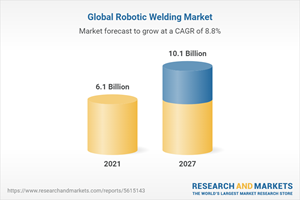Insights on the Robotic Welding Global Market to 2027 - by Type, Payload, End-user and Region

Global Robotic Welding Market

Dublin, July 08, 2022 (GLOBE NEWSWIRE) -- The "Robotic Welding Market: Global Industry Trends, Share, Size, Growth, Opportunity and Forecast 2022-2027" report has been added to ResearchAndMarkets.com's offering.
The global robotic welding market reached a value of US$ 6.08 Billion in 2021. Looking forward, the publisher expects the market to reach a value of US$ 10.1 Billion by 2027, exhibiting a CAGR of 8.83% during 2021-2027. Keeping in mind the uncertainties of COVID-19, we are continuously tracking and evaluating the direct as well as the indirect influence of the pandemic on different end use industries. These insights are included in the report as a major market contributor.
Robotic welding, also known as automated welding, is a process of fusing two materials together using mechanized programmable instruments that heat, mix, and cool metal materials. It ensures that weld integrity is enhanced with consistent results for fast quality welds while reducing human errors, fatigue and distractions that may cause defects.
As it helps in more accurate and precise welding, there are fewer scrap metals and wastes with robotic welding compared to manual welding. In addition, it performs different welding processes with less manpower and without the need for hiring additional staffing for production. As a result, it finds extensive applications in automotive, electronics, aerospace, defense, construction, and mining industries across the globe.
Robotic Welding Market Trends:
Due to reduced intensive labor injuries, improved order fulfilment speed and accuracy, and increased uptime with reduced costs, there is a rise in the utilization of robotic welding around the world. This, along with the growing demand for robotic welding to enhance the efficient use of working space and improve the supply chain performance in end-user industries, represents one of the key factors driving the market.
Moreover, key market players are extensively investing in research and development (R&D) activities to improve the functions and benefits offered by robotic welding. This, coupled with the rising customization of robotic welding for several requirements, such as cloud-based operations and remote monitoring, along with effective physical stature for improved compatibility with the human workforce, is positively influencing the market.
Additionally, the increasing employment of robotic welding in the automotive industry for resistance spot welding and arc welding in high production applications is offering lucrative growth opportunities to industry investors. Besides this, robotic welding requires minimal hard tooling as they are reprogrammable, which is projected to bolster the market growth.
Competitive Landscape:
The competitive landscape of the industry has also been examined along with the profiles of the key players being ABB Ltd., Comau (Stellantis N.V.), DAIHEN Corporation, FANUC Corporation, Hyundai Robotics Co. Ltd. (Hyundai Heavy Industries Group), Kawasaki Heavy Industries Ltd., KUKA AG, Nachi-Fujikoshi Corp., Panasonic Corporation, Siasun Robot & Automation Co. Ltd. and Yaskawa Electric Corporation.
Key Questions Answered in This Report:
How has the global robotic welding market performed so far and how will it perform in the coming years?
What has been the impact of COVID-19 on the global robotic welding market?
What are the key regional markets?
What is the breakup of the market based on the type?
What is the breakup of the market based on the payload?
What is the breakup of the market based on the end user?
What are the various stages in the value chain of the industry?
What are the key driving factors and challenges in the industry?
What is the structure of the global robotic welding market and who are the key players?
What is the degree of competition in the industry?
Key Topics Covered:
1 Preface
2 Scope and Methodology
3 Executive Summary
4 Introduction
4.1 Overview
4.2 Key Industry Trends
5 Global Robotic Welding Market
5.1 Market Overview
5.2 Market Performance
5.3 Impact of COVID-19
5.4 Market Forecast
6 Market Breakup by Type
6.1 Spot Welding
6.1.1 Market Trends
6.1.2 Market Forecast
6.2 Arc Welding
6.2.1 Market Trends
6.2.2 Market Forecast
6.3 Others
6.3.1 Market Trends
6.3.2 Market Forecast
7 Market Breakup by Payload
7.1 Less than 50 Kg
7.1.1 Market Trends
7.1.2 Market Forecast
7.2 50-150 Kg
7.2.1 Market Trends
7.2.2 Market Forecast
7.3 More than 150 Kg
7.3.1 Market Trends
7.3.2 Market Forecast
8 Market Breakup by End User
8.1 Automotive and Transportation
8.1.1 Market Trends
8.1.2 Market Forecast
8.2 Electrical and Electronics
8.2.1 Market Trends
8.2.2 Market Forecast
8.3 Metals and Machinery
8.3.1 Market Trends
8.3.2 Market Forecast
8.4 Others
8.4.1 Market Trends
8.4.2 Market Forecast
9 Market Breakup by Region
10 SWOT Analysis
11 Value Chain Analysis
12 Porters Five Forces Analysis
13 Price Analysis
14 Competitive Landscape
14.1 Market Structure
14.2 Key Players
14.3 Profiles of Key Players
14.3.1 ABB Ltd.
14.3.1.1 Company Overview
14.3.1.2 Product Portfolio
14.3.1.3 Financials
14.3.1.4 SWOT Analysis
14.3.2 Comau (Stellantis N.V.)
14.3.2.1 Company Overview
14.3.2.2 Product Portfolio
14.3.3 DAIHEN Corporation
14.3.3.1 Company Overview
14.3.3.2 Product Portfolio
14.3.3.3 Financials
14.3.4 FANUC Corporation
14.3.4.1 Company Overview
14.3.4.2 Product Portfolio
14.3.4.3 Financials
14.3.4.4 SWOT Analysis
14.3.5 Hyundai Robotics Co. Ltd. (Hyundai Heavy Industries Group)
14.3.5.1 Company Overview
14.3.5.2 Product Portfolio
14.3.6 Kawasaki Heavy Industries Ltd.
14.3.6.1 Company Overview
14.3.6.2 Product Portfolio
14.3.6.3 Financials
14.3.6.4 SWOT Analysis
14.3.7 KUKA AG
14.3.7.1 Company Overview
14.3.7.2 Product Portfolio
14.3.7.3 Financials
14.3.7.4 SWOT Analysis
14.3.8 Nachi-Fujikoshi Corp.
14.3.8.1 Company Overview
14.3.8.2 Product Portfolio
14.3.8.3 Financials
14.3.8.4 SWOT Analysis
14.3.9 Panasonic Corporation
14.3.9.1 Company Overview
14.3.9.2 Product Portfolio
14.3.9.3 Financials
14.3.9.4 SWOT Analysis
14.3.10 Siasun Robot & Automation Co. Ltd.
14.3.10.1 Company Overview
14.3.10.2 Product Portfolio
14.3.10.3 Financials
14.3.11 Yaskawa Electric Corporation
14.3.11.1 Company Overview
14.3.11.2 Product Portfolio
14.3.11.3 Financials
For more information about this report visit https://www.researchandmarkets.com/r/z1kzrq
Attachment
CONTACT: CONTACT: ResearchAndMarkets.com Laura Wood, Senior Press Manager press@researchandmarkets.com For E.S.T Office Hours Call 1-917-300-0470 For U.S./CAN Toll Free Call 1-800-526-8630 For GMT Office Hours Call +353-1-416-8900


 Yahoo Finance
Yahoo Finance 
